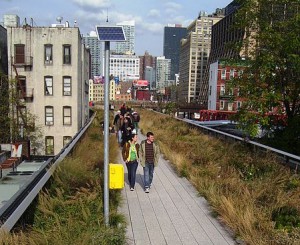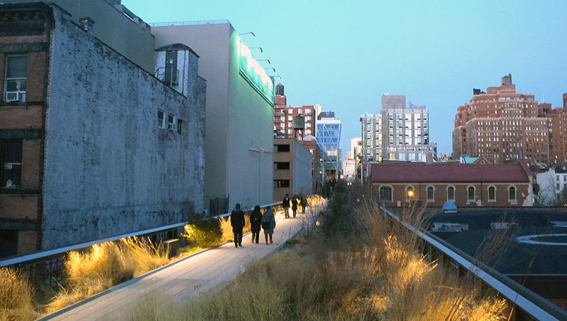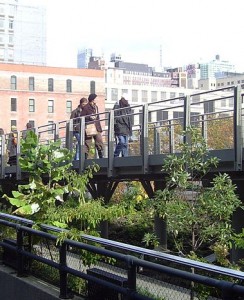Walking the High Line
Posted in Programs and Events on August 7 2012, by Sonia Uyterhoeven
Sonia Uyterhoeven is the NYBG‘s Gardener for Public Education.
 New York City has made a wonderful commitment to greening up the neighborhood and the High Line is one of its finest examples. It is one of many local initiatives–such as Hudson River Park, Brooklyn Bridge Park, A Million Trees, and Battery City Park–to bring nature back into the urban environment.
New York City has made a wonderful commitment to greening up the neighborhood and the High Line is one of its finest examples. It is one of many local initiatives–such as Hudson River Park, Brooklyn Bridge Park, A Million Trees, and Battery City Park–to bring nature back into the urban environment.
The High Line is the reclaimed site of an abandoned railroad track that has been turned into a vibrant park and a magnet for city dwellers. People swarm to the park during their lunch break or after work, and it has rapidly become a premier tourist attraction.
The park is emblematic of good city planning. It has user-friendly peel up benches that rise organically from the walkway and decadent chaise lounges that give a spectacular view of the Hudson. One of my favorite spots is the 10th Avenue viewing station. In an age where we are bombarded by electronic stimulation, the viewing station offers a place to congregate and quietly watch the city moving below.
Aesthetics and energy-efficiency are also combined in the park. The lights are LEED certified, integrated into the plantings and the railings, illuminating the pathways at night. The lights are set below eye-level so that visitors’ eyes can adjust to the ambient light of the city. There is no artificial disruption between the city and the park, just the seamless fusion between urban and natural environments.

The planting beds are laid out in a naturalistic style. The Dutch designer, Piet Oudolf, has organized the planting plan so that it mimics natural patterns in nature. The flora congregate and combine to form different ecological communities–a grassland, wetland, and a dry woodland. Not only have the plants been selected for their ornamental value, but their resiliency as well.
Parks such as the High Line are ecological opportunities. If we think of some of the problems that we are confronted with in the 21st century–urban sprawl, the loss of natural habitats, invasive plants and the possibility of climate change–parks such as the High Line offer gardeners and urban-dwellers a way to effectively and creatively address some of these environmental issues while adding to the enjoyment and the value of the city.
 For the gardener, the High Line is a plant paradise that offers a compendium of some of Mother Nature’s best. The plantings contain a long-list of prairie plants that tolerate sun, wind, drought and lean soils. The park also houses a collection of some fabulous understory trees and fine ornamental shrubs.
For the gardener, the High Line is a plant paradise that offers a compendium of some of Mother Nature’s best. The plantings contain a long-list of prairie plants that tolerate sun, wind, drought and lean soils. The park also houses a collection of some fabulous understory trees and fine ornamental shrubs.
Every year, from spring through November, I offer tours of the park to members of The New York Botanical Garden. The groups tend to be small–between 10 and 20 people–but the small size allows us to take more intimate walks through the park, exploring its architecture and ecology.
If you are interested in joining me, please contact our Membership department.
Photographs courtesy of Wikimedia Commons.

